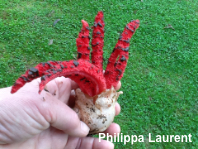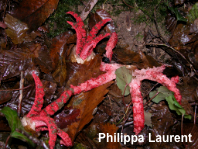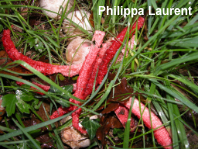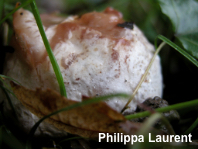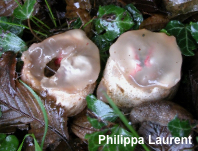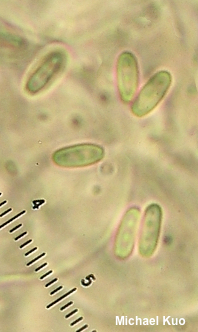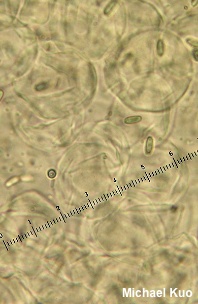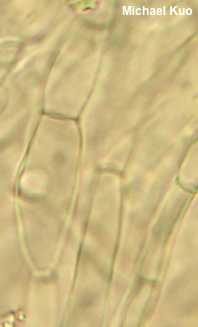| Major Groups > Stinkhorns > Clathrus archeri |

|
Clathrus archeri: The [ Basidiomycota > Agaricomycetes > Phallales > Clathraceae > Clathrus . . . ] by Michael Kuo When my son was two, he took one look at photos of this amazing stinkhorn and said, "appetee!" That was his word for "octopus" and "helicopter" (flip an octopus upside down in your mind and you'll see why he thought they were the same). So, since other authors have already coined the label "octopus stinkhorn" for this funky species, I have borrowed from my son's toddler vocabulary and will call it the "helicopter stinkhorn." In fact helicopter may be a more apt metaphor, since it is harder to imagine an octopus traveling from continent to continent—from Australia and New Zealand to Asia, Europe, and California, as Clathrus archeri may have done over the last 100–200 years. European mycologists speculate that the tropical Clathrus archeri arrived on their continent from Australia during World War I, with wool shipments or military rations. In North America it is known from the Santa Cruz, California area, where it may have been unintentionally imported with bamboo. Clathrus archeri features multiple, goo-covered arms that are joined at the base but separate above; in old age the arms often collapse outward onto the ground. Like other stinkhorns it emerges from an egg-like structure. Pseudocolus fusiformis is somewhat similar—but it features fewer arms, which are generally paler in color and usually remain joined at their tips. Anthurus archeri is a synonym. Thanks to Philippa Laurent for documenting, collecting, and preserving Clathrus archeri for study; her collection is deposited in The Herbarium of Michael Kuo. Description: Ecology: Saprobic; growing alone or gregariously—often in urban areas near woody debris, in lawns, gardens, cultivated soil, and so on; fruiting nearly year-round, depending on climate; subtropical, tropical, and Mediterranean climate regions in Oceania, Europe, Asia, eastern Africa, and northern California. The illustrated and described collection is from France. Immature Fruiting Body: Like a whitish "egg" up to about 5 cm high and 4 cm wide; surface spotted and discoloring pinkish brown in places; when sliced revealing the stinkhorn-to-be encased in a brownish gelatinous substance. Mature Fruiting Body: 8–17 cm high; 3–5 cm wide at the base; consisting of 4–7 arms that arise from a stemlike structure; arms soon separating and spreading outwards. Arms: 3–12 cm long; tapered to apices; red on the inner surfaces and slightly paler on the outer surfaces; fading to pink; finely pitted; hollow; spongy. Pseudostem: Up to about 4 cm high, whitish below and pinkish to reddish above, enclosed in a whitish volva and attached to white rhizomorphs. Volva: Sac-like, encasing the base of the fruiting body; whitish, with brownish spots and discolorations. Spore Slime: Dark brown to nearly black; covering the inner surfaces of the arms; malodorous. Microscopic Features: Spores 4.5–6 x 1.5–2 µm; subcylindric; smooth; hyaline in KOH. Sphaerocysts of the pseudostipe 15–30 µm; mostly subglobose; walls about 1 µm thick; hyaline in KOH. Hyphae of the volva 3–7 µm wide; smooth; walls less than 0.5 µm thick; hyaline in KOH; septate; clamp connections not found. REFERENCES: (Berkeley, 1860) Dring, 1980. (Saccardo, 1888; Cunningham, 1944/1979; Dring, 1980; Arora & Burk, 1982; Arora, 1986; Breitenbach and Kränzlin, 1986; Miller & Miller, 1988; Coetzee, 2010; Buczacki et al., 2012; Trierveiler-Pereira et al., 2014; Desjardin, Wood & Stevens, 2015; Siegel & Schwarz, 2016; Gminder & Böhning, 2017; Læssøe & Petersen, 2019.) Herb. Kuo 11091301. This site contains no information about the edibility or toxicity of mushrooms. |
© MushroomExpert.Com |
|
Cite this page as: Kuo, M. (2020, August). Clathrus archeri: The |
